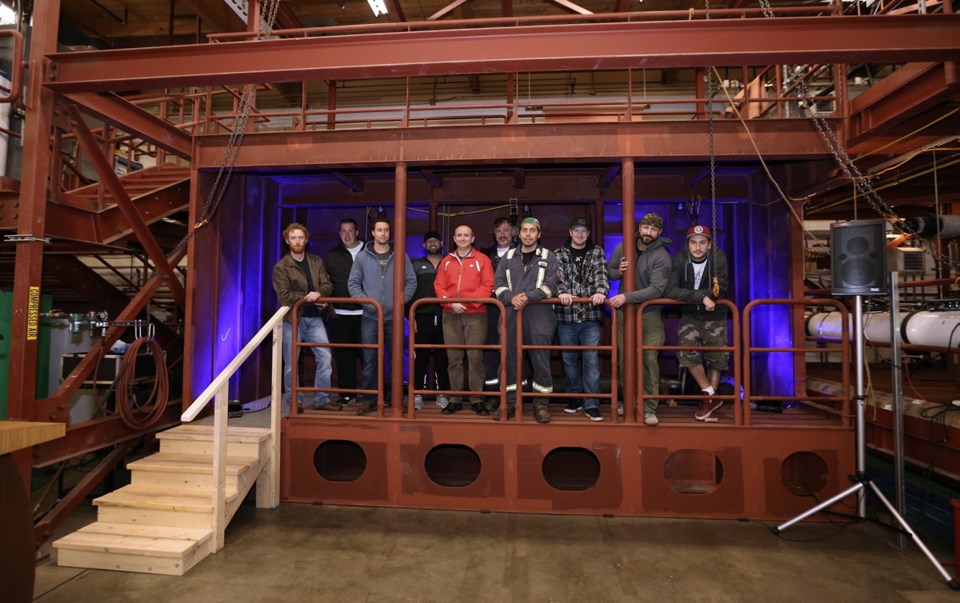A custom-made bulkhead newly installed at Camosun College will enhance training for skilled trades students heading into shipyards and other job sites.
Seaspan’s Victoria Shipyards designed, built and delivered the six-tonne, $88,000 bulkhead to Camosun’s Interurban campus.
Jamie McPherson, chairman of Camosun’s plumbing and pipe trades, called Seaspan’s donation “an invaluable tool not just for our department, but other trades.”
The model creates a “safe environment to learn some of the skills needed to be working on a bulkhead,” McPherson said at an unveiling ceremony on Tuesday attended by more than 80 people.
A bulkhead is like a dividing wall in a ship or on a plane.
Students will be learning how to work in confined spaces while at school, rather than on the job.
The bulkhead is part of the massive trades initiative at Camosun, which saw a $30-million trades building open in February and a $5-million campaign launched to renovate and update two existing trades buildings and buy new equipment. Western Economic Diversification also contributed $2.56 million to boost trades and manufacturing at the college.
The Camosun expansion is driven by soaring demand for trained trades workers in B.C. Baby boomers are retiring, major capital projects are underway or planned and new expertise and technologies are needed in the workplace. Camosun anticipates it will have room for 1,000 more students in the future, up from 2,700 now.
Revival of B.C.’s ship-repair and shipbuilding sector in recent years is spurring new training and new facilities in marine trades at Camosun. Expertise in marine work means students have opportunities to work in coastal communities.
Seaspan is building non-combat vessels for the federal government at its Vancouver Shipyard. Each of the ships will come to Victoria Shipyards for tests, trials and completion.
The first of those ships arrives next summer, said Joe O’Rourke, vice-president and general manager of Victoria Shipyards.
Trade schools feed into the company’s apprenticeship program and the high quality of trade workers gives the shipyard a key competitive edge, he said.
Referring to the bulkhead, O’Rourke said: “When we make an investment like this, this is an investment in our future.”
Victoria Shipyard operates at the Esquimalt Graving Dock where it works for public-sector and private-sector customers. Jobs include refitting luxury cruise ships, upgrading Canada’s submarines and modernizing Canadian navy frigates based on the West Coast.
“Our reputation of delivery and quality is unmatched by anyone on the West Coast and it is efforts like this and teaming arrangements with Camosun College that makes it all possible,” O’Rourke said. Although the shipyard is in a slow period, forecasted work in 2017 and 2018 looks to be “a little crazy, which is a good thing for us,” he said.
Connor Wells, 25, is in his second year as a pipefitter apprentice, working at Victoria Shipyards. Originally from Prince George, he considers employment opportunities “endless.”
Davin Fossum, a pipefitter at Victoria Shipyards for a decade, helped put the bulkhead together, bending the handrails on it.
He completed his training at Camosun. Looking around the upgraded facility, he said: “The place is completely different now. This is great. It is huge.”
Dale Dhillon, business manager for Local 324, United Association of Journeymen and Apprentices of the Plumbing and Pipe Fitting Industry, called the improved training and equipment such as the bulkhead “unbelievable.”
Of the local’s 900 members, 200 are in ship repair and shipbuilding.
This kind of training bolsters the coast’s ability for future work, such as transforming diesel-run ships into those powered by liquefied natural gas, he said.



